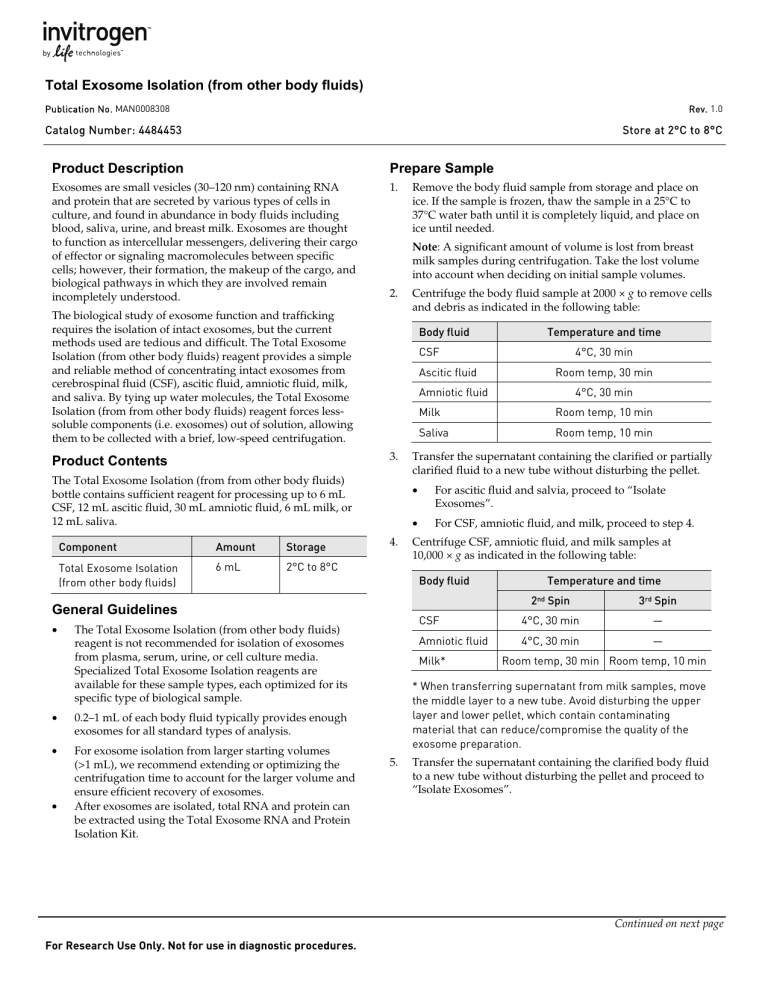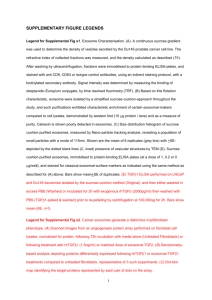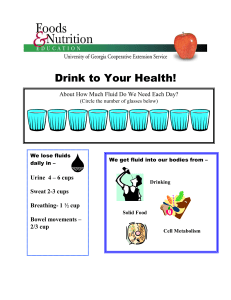
Total Exosome Isolation (from other body fluids)
Publication No. MAN0008308
Rev. 1.0
Catalog Number: 4484453
Store at 2°C to 8°C
Product Description
Prepare Sample
Exosomes are small vesicles (30–120 nm) containing RNA
and protein that are secreted by various types of cells in
culture, and found in abundance in body fluids including
blood, saliva, urine, and breast milk. Exosomes are thought
to function as intercellular messengers, delivering their cargo
of effector or signaling macromolecules between specific
cells; however, their formation, the makeup of the cargo, and
biological pathways in which they are involved remain
incompletely understood.
1.
Note: A significant amount of volume is lost from breast
milk samples during centrifugation. Take the lost volume
into account when deciding on initial sample volumes.
2.
The biological study of exosome function and trafficking
requires the isolation of intact exosomes, but the current
methods used are tedious and difficult. The Total Exosome
Isolation (from other body fluids) reagent provides a simple
and reliable method of concentrating intact exosomes from
cerebrospinal fluid (CSF), ascitic fluid, amniotic fluid, milk,
and saliva. By tying up water molecules, the Total Exosome
Isolation (from from other body fluids) reagent forces lesssoluble components (i.e. exosomes) out of solution, allowing
them to be collected with a brief, low-speed centrifugation.
Amount
Storage
Total Exosome Isolation
(from other body fluids)
6 mL
2°C to 8°C
0.2–1 mL of each body fluid typically provides enough
exosomes for all standard types of analysis.
•
For exosome isolation from larger starting volumes
(>1 mL), we recommend extending or optimizing the
centrifugation time to account for the larger volume and
ensure efficient recovery of exosomes.
After exosomes are isolated, total RNA and protein can
be extracted using the Total Exosome RNA and Protein
Isolation Kit.
•
Room temp, 30 min
Amniotic fluid
4.
4°C, 30 min
Milk
Room temp, 10 min
Saliva
Room temp, 10 min
Transfer the supernatant containing the clarified or partially
clarified fluid to a new tube without disturbing the pellet.
•
For ascitic fluid and salvia, proceed to “Isolate
Exosomes”.
•
For CSF, amniotic fluid, and milk, proceed to step 4.
Centrifuge CSF, amniotic fluid, and milk samples at
10,000 × g as indicated in the following table:
Body fluid
Temperature and time
nd
The Total Exosome Isolation (from other body fluids)
reagent is not recommended for isolation of exosomes
from plasma, serum, urine, or cell culture media.
Specialized Total Exosome Isolation reagents are
available for these sample types, each optimized for its
specific type of biological sample.
•
4°C, 30 min
Ascitic fluid
General Guidelines
•
Temperature and time
CSF
The Total Exosome Isolation (from from other body fluids)
bottle contains sufficient reagent for processing up to 6 mL
CSF, 12 mL ascitic fluid, 30 mL amniotic fluid, 6 mL milk, or
12 mL saliva.
Component
Centrifuge the body fluid sample at 2000 × g to remove cells
and debris as indicated in the following table:
Body fluid
3.
Product Contents
Remove the body fluid sample from storage and place on
ice. If the sample is frozen, thaw the sample in a 25°C to
37°C water bath until it is completely liquid, and place on
ice until needed.
2 Spin
3rd Spin
CSF
4°C, 30 min
—
Amniotic fluid
4°C, 30 min
—
Milk*
Room temp, 30 min Room temp, 10 min
* When transferring supernatant from milk samples, move
the middle layer to a new tube. Avoid disturbing the upper
layer and lower pellet, which contain contaminating
material that can reduce/compromise the quality of the
exosome preparation.
5.
Transfer the supernatant containing the clarified body fluid
to a new tube without disturbing the pellet and proceed to
“Isolate Exosomes”.
Continued on next page
For Research Use Only. Not for use in diagnostic procedures.
Isolate Exosomes
Resuspend Exosomes
1.
1.
Transfer the required volume of clarified body fluid to a
new tube and add the volume of Total Exosome Isolation
(from other body fluids) reagent, as in the following table:
Body fluid
CSF
Ascitic fluid
Amniotic fluid
Milk*
Saliva
2.
3.
4.
5.
6.
7.
Body fluid
Reagent
1 vol
0.5 vol
0.2 vol
0.5 vol
0.5 vol
*Add 1 volume of 1X PBS to clarified milk samples and mix
prior to adding Total Exosome Isolation (from other body
fluids) reagent. The reagent volume is based on the total
volume of milk plus PBS. For example, if you are isolating
exosomes from 200 µL of milk, add 200 µL of 1X PBS and
200 µL of reagent (0.5 volumes of 400 µL).
Mix the body fluid/reagent mixture by inverting the tube,
vortexing, or pipetting up and down until the solution is
homogenous.
Incubate the sample according to the type of body fluid as
indicated in the following table:
Body fluid
Temperature and time
CSF
2°C to 8°C, 1h
Ascitic fluid
Room temp, 30 min
Amniotic fluid
Room temp, 30 min
Milk
Room temp, 30 min
Saliva
2°C to 8°C, 1h
After incubation, centrifuge the sample at 10,000 × g
according to the type of body fluid as indicated in the
following table:
Body fluid
Temperature and time
CSF
2°C to 8°C, 1h
Ascitic fluid
Room temp, 10 min
Amniotic fluid
2°C to 8°C, 1h
Milk
Room temp, 10 min
Saliva
2°C to 8°C, 1h
Aspirate the supernatant by pipetting and discard.
Exosomes are contained in a pellet (which may not be
visible) at the bottom of the tube.
(Optional) Centrifuge the tube at room temperature for
5 minutes at 10,000 × g to collect any residual reagent.
Discard any residual supernatant by careful aspiration with
a pipet and proceed to “Resuspend Exosomes.”
Add 1X PBS or similar buffer to the pellet. Examples of
typical volumes are shown in the following table:
Starting Volume
(after clarification)
Resuspension
Volume
700 µL
50–75 µL
CSF
2.
3.
4.
5.
Ascitic fluid
200 µL
25–50 µL
Amniotic fluid
200 µL
25–50 µL
Milk
200 µL
25–50 µL
Saliva
500 µL
25–50 µL
Vortex or pipet up and down to resuspend the exosomes.
•
For ascitic fluid, amniotic fluid, and saliva samples,
proceed to step 5.
•
For CSF and milk samples, proceed to step 3.
Centrifuge resuspended exosomes at 10,000 x g for
5 minutes at room temperature.
Transfer the supernatant to a new tube. Avoid disturbing
the pellet which contains non-organic particulate matter.
Isolated exosomes are ready for downstream analysis or
further purification through affinity methods.
Keep isolated exosomes at 2°C to 8°C for up to 1 week, or at
−20°C or colder for long-term storage.
Related Products
Product
Cat. no.
Total Exosome RNA and Protein Isolation Kit
4478545
Total Exosome Isolation (from serum)
4478360
Total Exosome Isolation (from cell culture media)
4478359
Total Exosome Isolation (from urine)
4484452
Total Exosome Isolation (from plasma)
4484450
Exosome- Human CD63 Isolation/Detection (from cell
culture media)
10606D
Exosome Spin Columns (MW3000)
4484449
Exosome- Streptavidin Isolation/Detection
10608D
Exosome Immunoprecipitation (Protein A)
10610D
Exosome Immunoprecipitation (Protein G )
10612D
Nuclease-Free Water (not DEPC-Treated) (1 x 100 mL)
AM9938
PBS - Phosphate-Buffered Saline 10X, pH 7.4
AM9624
Non-Stick RNase-free Microfuge Tubes (2.0 ml)
AM12475
Non-Stick RNase-free Microfuge Tubes (1.5 ml)
AM12450
Conical Tubes (50 ml) (Racked)
AM12501
Conical Tubes (15 ml) (Racked)
AM12500
Limited Use Label License: Research Use Only
The purchase of this product conveys to the purchaser the limited, non-transferable right to use the purchased amount of the product only to perform internal research for the sole benefit of the
purchaser. No right to resell this product or any of its components is conveyed expressly, by implication, or by estoppel. This product is for internal research purposes only and is not for use in
commercial applications of any kind, including, without limitation, quality control and commercial services such as reporting the results of purchaser’s activities for a fee or other form of
consideration. For information on obtaining additional rights, please contact outlicensing@lifetech.com or Out Licensing, Life Technologies, 5791 Van Allen Way, Carlsbad, California 92008.
Limited Product Warranty
Life Technologies Corporation and/or its affiliate(s) warrant their products as set forth in the Life Technologies’ General Terms and Conditions of Sale found on Life Technologies’ website at
www.lifetechnologies.com/termsandconditions. If you have any questions, please contact Life Technologies at www.lifetechnologies.com/support.
DISCLAIMER: LIFE TECHNOLOGIES CORPORATION AND/OR ITS AFFILIATE(S) DISCLAIM ALL WARRANTIES WITH RESPECT TO THIS DOCUMENT, EXPRESSED OR IMPLIED, INCLUDING
BUT NOT LIMITED TO THOSE OF MERCHANTABILITY, FITNESS FOR A PARTICULAR PURPOSE, OR NON-INFRINGEMENT. TO THE EXTENT ALLOWED BY LAW, IN NO EVENT SHALL LIFE
TECHNOLOGIES AND/OR ITS AFFILIATE(S) BE LIABLE, WHETHER IN CONTRACT, TORT, WARRANTY, OR UNDER ANY STATUTE OR ON ANY OTHER BASIS FOR SPECIAL, INCIDENTAL,
INDIRECT, PUNITIVE, MULTIPLE OR CONSEQUENTIAL DAMAGES IN CONNECTION WITH OR ARISING FROM THIS DOCUMENT, INCLUDING BUT NOT LIMITED TO THE USE THEREOF.
©2013 Life Technologies Corporation. All rights reserved. The trademarks mentioned herein are the property of Life Technologies Corporation and/or its
affiliate(s) or their respective owners.
For support visit lifetechnologies.com/support or email techsupport@lifetech.com
lifetechnologies.com
28 June 2013



